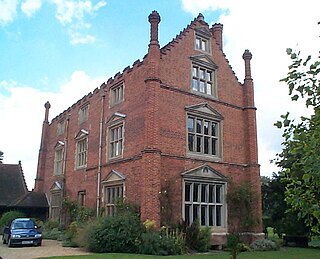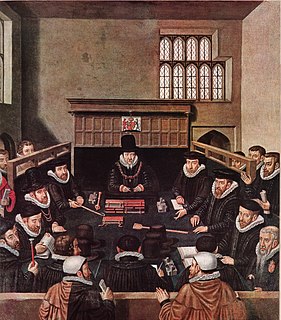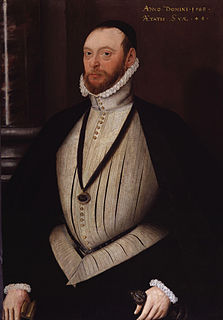Related Research Articles

Sir John Suckling was an English politician who sat in the House of Commons at various times between 1601 and 1627.

Thomas Seckford Esquire was a senior lawyer, a "man of business" at the court of Queen Elizabeth I, a Suffolk landowner, Member of Parliament, and public benefactor of the town of Woodbridge. He was one of the Masters in Ordinary of the Court of Requests to Queen Elizabeth, 1569-1587, and was Surveyor of the Court of Wards and Liveries 1581-1587. He built mansions in Woodbridge, Ipswich and Clerkenwell, and was at different times Steward of the Liberty of Ely in Suffolk, Bailiff for the Crown of the former possessions of Clerkenwell Priory in the City of London and County of Middlesex, and deputy Steward for the northern parts of the Duchy of Lancaster. He was the patron of Christopher Saxton in the making of the first surveyed County Atlas of England and Wales.
Sir Robert Bell SL of Beaupré Hall, Norfolk, was a Speaker of the House of Commons (1572–1576), who served during the reign of Queen Elizabeth I.

Thomas Wentworth, 2nd Baron Wentworth was an English peer, courtier, administrator and military commander during the reigns of Edward VI, Mary and Elizabeth. His reputation suffered through the surrender of Calais in 1558, which occurred under his command.

Sir Clement Higham, or Heigham, of Barrow, Suffolk, was an English lawyer and politician, a Speaker of the House of Commons in 1554, and Chief Baron of the Exchequer in 1558-1559. A loyal Roman Catholic, he held various offices and commissions under Queen Mary, and was knighted in 1555 by King Philip, but withdrew from politics after the succession of Queen Elizabeth I in 1558.
This is a list of Sheriffs of Norfolk and Suffolk. The Sheriff is the oldest secular office under the Crown and is appointed annually by the Crown. He was originally the principal law enforcement officer in the county and presided at the Assizes and other important county meetings. After 1576 there was a separate Sheriff of Norfolk and Sheriff of Suffolk.
Sir Nicholas le Strange of Hunstanton, Norfolk, was an English Member of Parliament (MP).
Walter Haddon LL.D. (1515–1572) was an English civil lawyer, much involved in church and university affairs under Edward VI, Queen Mary, and Elizabeth I. He was a Cambridge humanist and reformer, and was highly reputed in his time as a Latinist: his controversial exchange with the Portuguese historian Jerónimo Osório attracted international attention based largely on the scholarly reputations of the protagonists.

William Dunch (1508–1597) was an English politician, a local official in the counties of Berkshire and Oxfordshire and Auditor of the Royal Mint for Kings Henry VIII and Edward IV.

Sir Anthony Wingfield KG, MP, of Letheringham, Suffolk, was an English soldier, politician, courtier and member of parliament. He was the Lord Lieutenant of Suffolk from 1551 to 1552, and Vice-Chamberlain of the Household in the reign of Edward VI.
Sir Richard Bulkeley was a Welsh politician.
Henry Cheyne, 1st Baron Cheyne was an English politician.
Sir Edmund Rous, of Dunwich, Suffolk, was an English landowner, magistrate, MP and Vice-Treasurer of Ireland.

Edmund Withypoll, Esquire, of London, of Walthamstow, Essex, and of Ipswich, Suffolk, was an English merchant, money-lender, landowner, sheriff and politician, who established his family in his mother's native county of Suffolk, and built Christchurch Mansion, a distinguished surviving Tudor house, as his Ipswich home.
Sir Henry Gates, of Seamer, Yorkshire; Kilburn, Middlesex; Kew, Surrey and Havering, Essex, was an English courtier and politician.
Sir George Blount was an English politician.
Sir Thomas Cornwallis was an English politician.
William Gerard was an English Member of Parliament for the constituencies of Preston and Wigan during the reigns of Mary I and Elizabeth I of England.
Roger Kelke (1524–1576) was an English churchman and academic, a Marian exile and Master of Magdalene College, Cambridge from 1558 and Archdeacon of Stow from 1563.
Edward Grimston may refer to:
References
- ↑ "GRIMSTON, Edward (c.1508-1600), of Rishangles, Suff. - History of Parliament Online". www.historyofparliamentonline.org.
- 1 2 3 4 5 6 7 . Dictionary of National Biography . London: Smith, Elder & Co. 1885–1900.
- Attribution
![]() This article incorporates text from a publication now in the public domain : "Grimston, Edward". Dictionary of National Biography . London: Smith, Elder & Co. 1885–1900.
This article incorporates text from a publication now in the public domain : "Grimston, Edward". Dictionary of National Biography . London: Smith, Elder & Co. 1885–1900.